I’ve grown Cardinal Climber (Ipomoea sloteri) for years. It’s a highlight in my garden. This annual vine blooms with bold red flowers from midsummer to frost. It’s perfect for attracting hummingbirds and butterflies.
It needs 6–8 hours of sun daily and weekly watering once it’s established. Seeds sprout in 5–15 days when soaked or gently scarified. Plant them 24 inches apart and they’ll climb 10–15 feet on sturdy trellises.
It’s low-maintenance and toxic to pests like deer. It rewards patience with blooms that last until autumn’s first frost. This guide covers everything from seed starting to troubleshooting. It’s easy for beginners to master Cardinal Climber care tips.
Why I Fell in Love with Cardinal Climbers
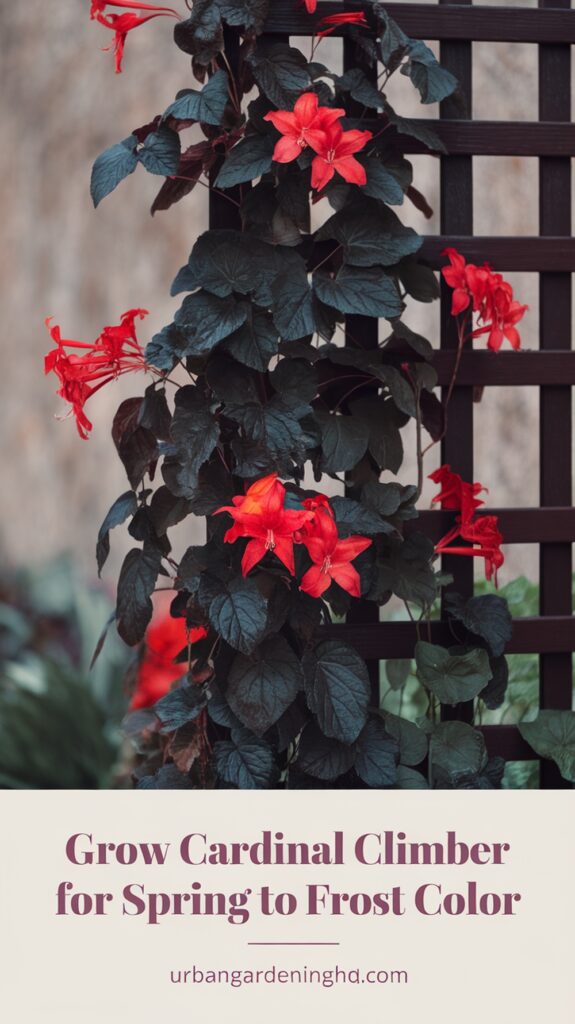
My journey with Cardinal Climbers started on a spring morning. I was walking past a neighbor’s fence when I saw them. The red blooms clinging to a trellis caught my eye.
My First Encounter with These Vibrant Climbers
The vines stretched up, with bright red flowers against green leaves. I found out they need Cardinal Climber sunlight requirements—full sun to grow fast. Their strength and deer resistance made me want to try them.
The Unique Characteristics That Won Me Over
- Velvety red flowers, 2–3 inches long, bloom nonstop from spring until frost.
- Lacy, triangular leaves create a delicate screen while the vines climb aggressively.
- Self-seeding annuals that return yearly if conditions match their best conditions for Cardinal Climber: well-drained soil and 6–8 hours of daily sun.
These plants are more than just pretty. They attract pollinators. Hummingbirds visit the flowers every day, making my garden a wildlife haven.
How Cardinal Climbers Transformed My Garden
Planting them along my fence changed my garden. Their growth turned an ugly fence into a beautiful tapestry. By meeting their Cardinal Climber sunlight requirements, I enjoyed blooms from June to November. The vines also keep pests away, saving me time. Every spring, I plant new seeds, knowing they’ll bring vibrant colors again.
Understanding the Cardinal Climber: Plant Profile and Background
Cardinal Climber (Ipomoea sloteri) was a gardener’s dream come true. In 1897, Ohio’s Logan Sloter worked for 11 years to mix red morning glory and cypress vine. His hard work paid off in 1908, creating a hybrid that reliably grows true to its parents.
This annual vine is often confused with Cardinal Flower. But it stands out with its vibrant red blooms from summer to frost. It’s a real showstopper in any garden.
Its leaves are lacy and fern-like, thanks to its cypress vine roots. The flowers are trumpet-shaped, red with a white throat, like morning glories. It grows 6–15 feet tall and loves full sun and slightly neutral soil.
Seeds need a little help to grow. Plant them ¼ inch deep and 6–12 inches apart.
| Feature | Detail |
|---|---|
| Height | 6–15 ft |
| Flower Size | 1 inch |
| Bloom Period | Summer to frost |
| USDA Zones | Annual in 3–7, short-lived perennial in 8–10 |
| Water Needs | 1 inch/week |
Even though it’s toxic to pets and humans, it attracts butterflies and hummingbirds with its nectar. Knowing it’s a hybrid helps gardeners prepare for its strong growth. It’s also drought-tolerant once it’s settled, making it great for adding color from spring to frost.
Remember to wear gloves when handling seeds. They contain toxic alkaloids.
How to Grow Cardinal Climber for Spring to Frost Color
Follow this Cardinal Climber planting guide to make your vines flourish. These tips cover timing, soil preparation, and care. They help your plants bloom from spring’s warmth to fall’s cool.
Starting seeds takes time. Timing is key: plant indoors 4-6 weeks before the last frost. Scrape seeds lightly with a nail file, soak them overnight, and plant ¼-inch deep in seed starter. Keep the soil moist but not too wet. Seeds will sprout in 5-15 days, thin them to 10-12 inches apart when true leaves grow.
Transplanting seedlings needs care. Use egg cartons or starter blocks to avoid damaging roots. Gradually move plants outdoors for a few hours each day for a week. Plant them outside after the frost danger has passed, spacing them 12 inches apart. Their 1/4-inch-wide stems need support to climb well.
- Use trellises at least 10-15 feet tall to accommodate rapid vertical growth
- Mulch lightly to retain moisture but allow soil to dry slightly between waterings
To get the most blooms, place plants in full sun (6-8 hours daily) and neutral soil (pH 6.0-7.2). Pinch the tips of young vines to encourage more branches. Water deeply once a week, more often in dry spells. In USDA zones 10-12, these annual vines may spread a lot—watch out for that in warm areas.
Perfect Growing Conditions for Thriving Cardinal Climbers
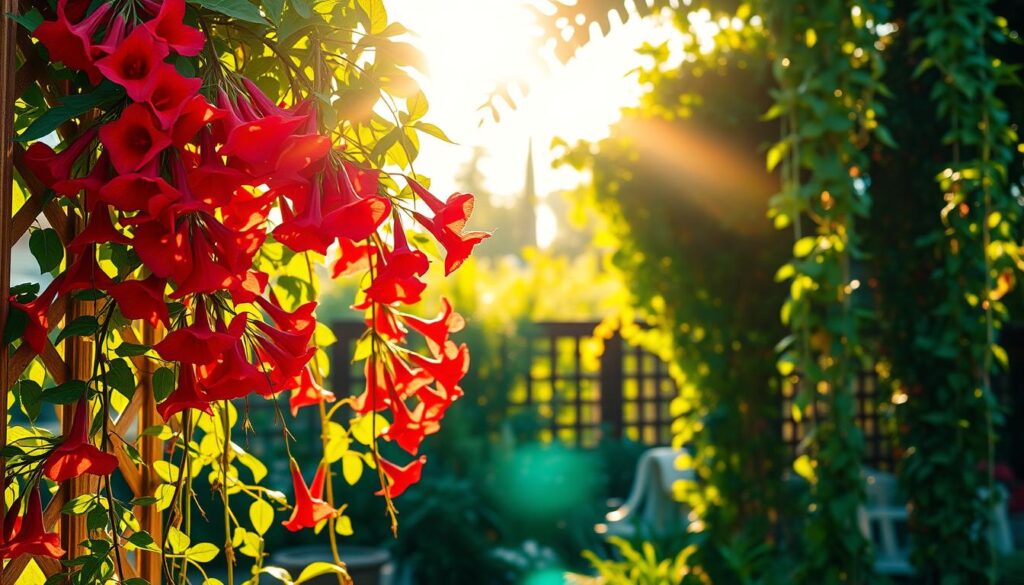
To grow Cardinal Climbers well, start with lots of sunlight. They need 6–8 hours of full sun each day. This ensures their red blooms are bright and they grow strong. My garden does best when plants get direct sunlight. But, they will bloom less in partial shade.
Soil Requirements and Preparation
Start by loosening the soil to 6 inches deep. Then, mix in compost to help with drainage. The soil should have a pH of 6.0–7.2. Avoid making the soil too rich, as it can cause more leaf growth than blooms. I get my beds ready by removing weeds and making sure the soil is loose and drains well.
Temperature and Climate Considerations
Cardinal Climbers love the heat. They grow as annuals in USDA zones 3–9 and as perennials in zones 10–12. Wait until the soil warms up to 65°F before planting. Frost can kill their tender stems, so plant after the last frost date. They can handle humidity but need warmth to start growing.
Ideal Planting Locations in Your Garden
Look for sunny spots, like south/west facing walls or fences.
- Plant near trellises for vertical growth
- Avoid shaded corners to maximize blooming
- Containers work well if placed in sunny patioss
While partial shade can help in hot climates, it will reduce blooms.
Cardinal Climber Watering and Moisture Needs
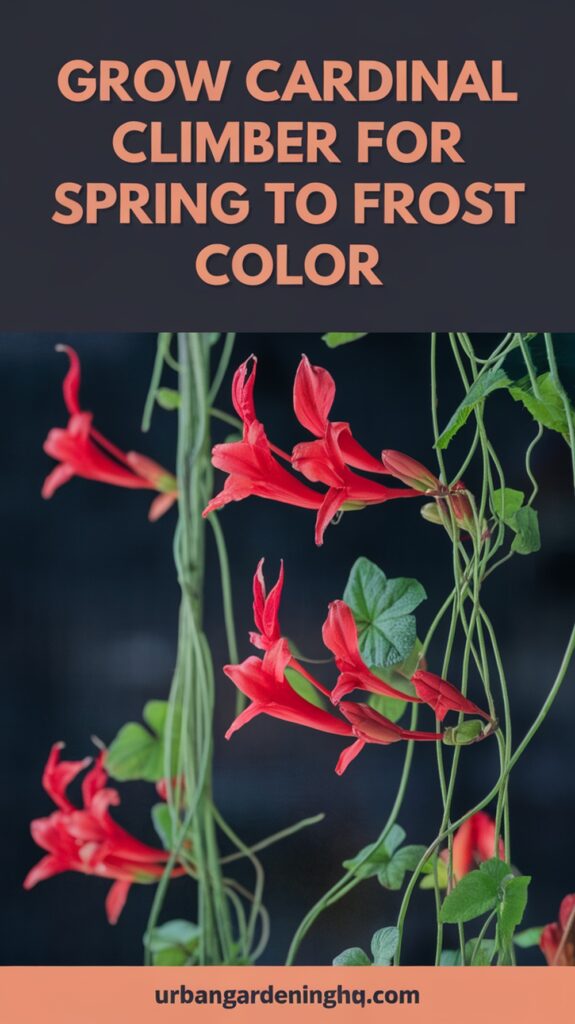
Understanding Cardinal Climber watering needs starts with knowing their roots. These vines do well with consistent moisture. An inch of water weekly, from rain or a hose, keeps blooms bright.
New seedlings need deeper, regular watering to grow roots. Mature plants can handle drought but bloom best with regular watering.
To check soil moisture, dig gently an inch below the surface. If it’s dry, it’s time to water. Cardinal Climber care tips stress good drainage.
For containers, water more often because potting mix dries faster. I use a soaker hose to soak the soil deeply. This encourages roots to grow downward instead of staying shallow.
- Water deeply once or twice weekly, depending on weather.
- Avoid overhead watering to prevent leaf diseases.
- In summer heat, increase watering frequency but let soil dry slightly between sessions.
- Mulch around plants to retain moisture, but keep it 2 inches from stems.
I’ve noticed blooms drop if plants get too dry, so consistency matters. During spring and fall, cut back to weekly watering. In winter, reduce further if growth slows.
Overwatering causes yellow leaves, so balance is key. Following these Cardinal Climber care tips ensures lush growth and nonstop color from spring through frost.
Supporting Your Cardinal Climber: Trellises and Structures
Having strong Cardinal Climber trellis support is essential to show off its vibrant blooms. My garden thrives with structures that match its 15-foot spread. This keeps growth in check and prevents tangling.
For example, a sturdy obelisk in containers lets vines spiral upward. This turns pots into eye-catching features.
DIY Trellis Ideas That Work Well
These structures fit the vine’s twining nature:
- Bamboo teepees: Three to five stakes tied at the top create a natural focal point.
- Ladder trellises: Repurposed ladders offer a rustic backdrop for blooms.
- String grids: Horizontal strings on fences guide vines into geometric patterns.
- Container obelisks: Metal or wooden pyramids add height to pots.
| Type | Best Use | Strength |
|---|---|---|
| Obelisk | Containers | Shows off vertical growth |
| Ladder | Fences or walls | Rustic charm and durability |
| String Grid | Privacy screens | Easy to customize |
Training Techniques for Optimal Growth
Start training early to direct growth:
- Guide shoots weekly: Gently nudge tendrils toward supports gaps.
- Use soft ties: Loop twine loosely around stems and stakes.
- Trim side shoots: Focus energy upward to boost flowering.
Creative Ways I’ve Used Cardinal Climbers in My Landscape
I’ve turned vines into living art. An arbor draped with red blooms creates a hummingbird hotspot. Near my patio, a string grid on a chain-link fence softens the view with lacy foliage.
Combining Cardinal Climbers with sunflowers in mixed pots adds drama. Just ensure structures can handle their vigorous growth—mine reached 18 feet last year! For more vertical ideas, check out UrbanGardeningHQ’s spring solutions.
Fertilizing Schedule That Maximizes Blooms

Cardinal Climbers are simple to care for, including their feeding. My experience shows that less is more with Cardinal Climber fertilizing schedule. Too much food can make vines leafy but few blooms. So, I focus on the right amount at the right time.
Organic vs. Synthetic Fertilizer Options
I’ve tried both, and here’s what works:
- Organic choices: Compost tea or fish emulsion feed gently, boosting soil health without pushing excess foliage. Seaweed extracts add trace minerals without overstimulating growth.
- Synthetic options: A diluted 10-10-10 fertilizer (half the package rate) keeps plants nourished without overwhelming them. Use only if soil tests show deficiencies.
My Season-by-Season Feeding Routine
Here’s how I time my applications to align with their bloom cycle:
- Spring: Mix a handful of compost into soil at planting. No extra feed until vines reach 12” tall.
- Summer: Apply diluted fertilizer every 4-6 weeks if blooms slow. Skip if plants are growing strongly on their own.
- Fall: Stop feeding 6 weeks before frost. Let vines focus energy on root storage instead of new growth.
Container plants get a half-strength dose every 3-4 weeks because nutrients wash out faster. A sign of overfeeding? Vines grow fast but don’t bloom. When I see this, I pause feeding and let nature reset. These Cardinal Climber care tips keep blooms in focus, not just greenery.
Pruning and Maintenance to Encourage Continuous Flowering
Cardinal Climber pruning techniques are all about gentle guidance. These vines bloom best with light touch-ups. My approach ensures lush foliage and steady color all season long. Here’s how to keep them thriving with minimal effort.
- Pinch young vines when they hit 6 inches tall to encourage bushy growth.
- Trim straggly shoots in midsummer to shape and control sprawl.
- Remove seed pods after blooms fade to redirect energy toward new flowers production.
| Task | Action |
|---|---|
| Deadheading | No need! Let spent blooms drop naturally. |
| Winter Prep | In zones 10-12, leave stems intact. In colder zones, cut back and save seeds for spring. |
| Yellow Leaves | Pull them weekly to boost airflow and cut disease risk. |
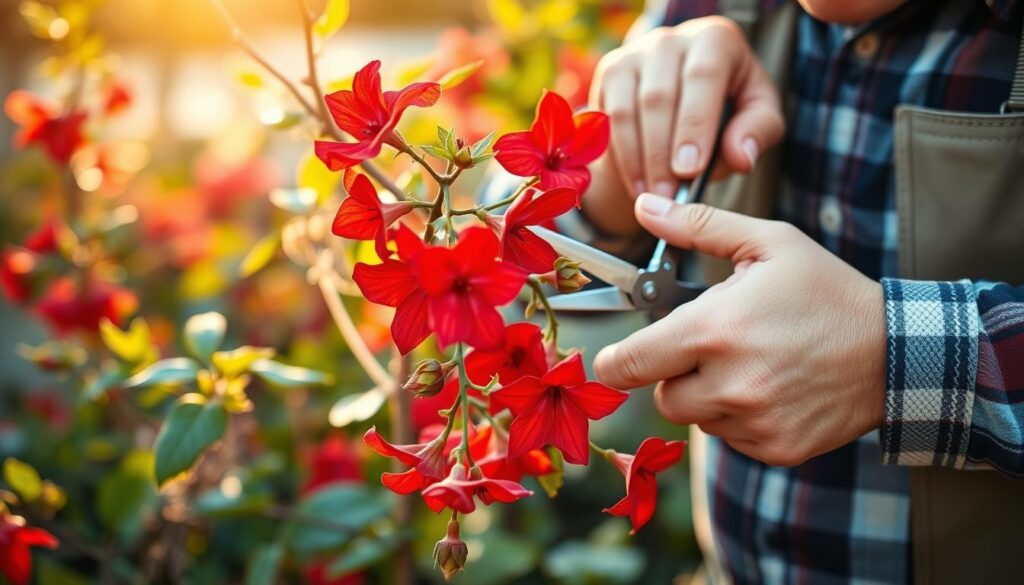
Cardinal Climber care tips include checking support ties monthly to avoid stem damage. In fall, mulch roots with 2 inches of compost. For northern gardens, collect seeds before winter to replant next year. Even in Zone 6, they come back strong with this routine. My plants flower nonstop using these simple steps.
Troubleshooting Common Cardinal Climber Problems
Even hardy plants like the Cardinal Climber can face minor issues. These tips help you spot and fix problems before they affect your garden. Following these Cardinal Climber care tips keeps vines thriving in the best conditions for Cardinal Climber.
Pests That May Affect Your Plants
While Cardinal Climbers rarely suffer from pests, crowded vines might attract whiteflies. I treat these with insecticidal soap or a blast of water. For aphids or spider mites, neem oil works well. Always check new growth weekly.
Disease Identification and Treatment
Overly moist soil or poor air flow can cause powdery mildew—white powder on leaves. To prevent this, space plants 18-24 inches apart. Remove infected leaves and spray with organic fungicide. Seed Needs’ seeds, which I use, ensure strong starts when planted in well-drained soil.
Fixing Growth and Blooming Issues
If seedlings fail to sprout, check soil temps—they need 70°F+. Soak seeds 24 hours before planting. For leggy vines, prune to encourage bushier growth. Less blooms? Move to full sun and cut back nitrogen-heavy fertilizers.
| Issue | Common Cause | Quick Fix |
|---|---|---|
| Yellow leaves | Overwatering or poor drainage | Let soil dry; add compost for better drainage |
| Wiltinged vines | Heat stress or drought | Water deeply and mulch roots |
| Few flowers buds | Low light or overfertilizing | Trim back foliage and increase sun exposure |
Conclusion: Enjoying the Rewards of Cardinal Climber Gardening
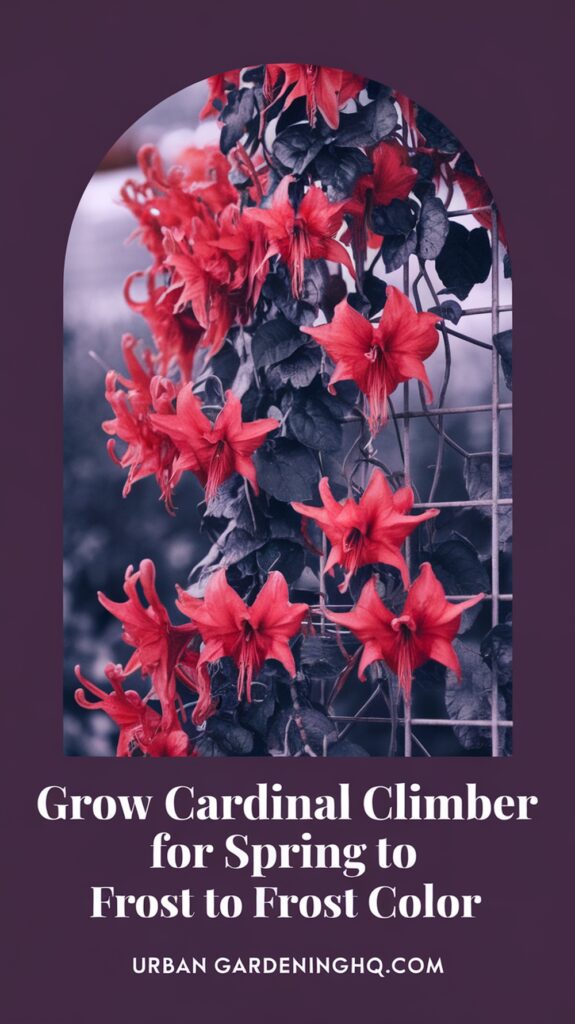
My garden comes alive every spring with Cardinal Climber vines. They cascade over trellises, filling the space with color until frost. Their bright blooms attract hummingbirds and butterflies, making my garden a lively spot.
These vines are easy to care for. They need a sturdy support and well-draining soil. By following the right Grow Cardinal Climber for Spring to Frost Color tips, even small spaces can look vibrant.
It’s important to water them right. Water deeply but not too often. Let the soil dry a bit between waterings to avoid root rot. Trellises help direct water, and mulch keeps the soil moist.
Cardinal Climbers can grow up to 15 feet or spread as groundcover. They do well in containers as shallow as 12 inches with sturdy stakes. They self-seed, so new plants appear every year. Prune spent blooms to control their spread if needed.
These plants grow fast in spring and bloom late into the season. They need little care but attract pollinators all season. Start seeds in sunny spots with rich soil. With the right support and drainage, they’ll be a beautiful addition to your garden for years.


